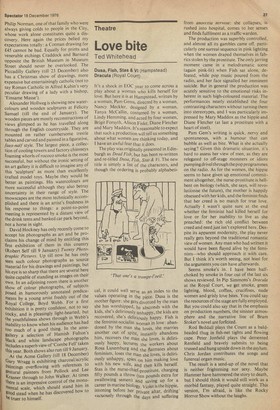Theatre
Love bite
Ted Whitehead
Dusa, Fish, Stas & Vi (Hampstead) Dracula (Royal Court)
It's a shock in EOC year to come across a play about a woman who kills herself for love. But here it is at Hampstead, written by a woman, Pam Gems, directed by a woman, Nancy Meck ler, designed by a woman, Tanya McCallin, costumed by a woman, Lindy Hemming, and acted by four women, Brigit Forsyth, Alison Fiske, Diane Fletcher and Mary Maddox. It's reasonable to expect that such a production will tell us something about what women are thinking today, and I have an awful fear that it does.
The play was originally presented in Edinburgh as Dead Fish, but has been re-written and re-titled Dusa, Fish, Stas & Vi. The new title is simply a list of the characters, and though the ordering
is probably alphabeti
'That one's a trompe-I'oeil.' cal, it could well serve as an index to the values operating in the piece. Dusa is the mother figure: she gets divorced by the man she has worshipped, he absconds with the kids, she's deliriously unhappy, the kids are recovered, she's deliriously happy. Fish is the feminist-socialist
woman in love: aban
doned n doned by the man she loves, she marries another out of spite, instantly abandons shim, recovers the man she loves, is deliriously happy, lectures
the workers about Rosa Luxemburg and the flatmates about feminism, loses the
man she loves, is deliriously unhappy, spies on him making love with his new wife, and then kills herself. Stas is the nurse-thief-prostitute, charging fifty pounds a throw (ten pounds extra for swallowing semen) and saving up for a career in marine biology. violet is the hippie, intoning before her Private altar, drifting' vacuously through the days and suffering
from anorexia nervosa: she collapses, is rushed into hospital, comes to her senses and finds fulfilment as a traffic warden.
The production was superbly controlled, and almost all its gambles came off, parti cularly one surreal sequence in pink lighting when the women draped themselves in fabrics stolen by the prostitute. The only jarring moment came in a melodramatic scene (again pink-lit) when Fish sat alone, defeated, while pop music poured from the radio, and her face signalled her imminent suicide. But in general the production was acutely sensitive to the emotional risks inherent in such high-coloured material. The performances neatly established the four contrasting characters without turning them into stereotypes, and I was particularly impressed by Mary Maddox as the hippie and Diane Fletcher (at last a prostitute with a heart of steel).
Pam Gem's writing is quick, nervy and spontaneous, with a humour that can bubble as well as bite. What is she actually saying? Given this dramatic situation, it's hard to assess her view of men, as they are relegated to off-stage monsters or idiots pumping drivel through the pop programmes on the radio. As for the women, the hippie seems to have given up emotional commitment altogether, the nurse-prostitute is hellbent on biology (which, she says, will revolutionise the future), the mother is happily obsessed with her kids, and the feminist finds that her creed is no match for true love. Actually I wasn't quite sure at the end whether the feminist had killed herself for love or for her inability to live as she preached: the rich old conflict between creed and need just isn't explored here. Despite its apparent modernity, the play never really gets beyond the traditional romantic view of women. Any man who had written it would have been flayed alive by the feminists—who should approach it with care. But I think it's worth seeing, not least for the arguments you can have afterwards.
Seems smoke's in. I have been halfchoked by smoke in four out of the last six shows reviewed. In Pip Simmons's Dracula at the Royal Court, we get smoke, green lighting, blood, coffins, crucifixes, nude women and grisly love bites. You could say the resources of the stage are fully employed. But you could also say that in the emphasis on production numbers, the sinister atmosphere and the narrative line of Bram Stoker's novel are forfeited.
Rod Beddall plays the Count as a baldheaded thug in fish-net tights and flowing cape. Peter Jonfield plays the demented Renfield and bravely submits to being trussed and hung upside down in the asylum. Chris Jordan contributes the songs and funereal organ music.
The result is a send-up of the novel that is neither frightening nor sexy. Maybe Hammer have hammered the story to death, but I should think it would still work as a morbid fantasy, played quite straight. This version, I'm afraid, is like the Rocky Horror Show without the laughs.














































 Previous page
Previous page